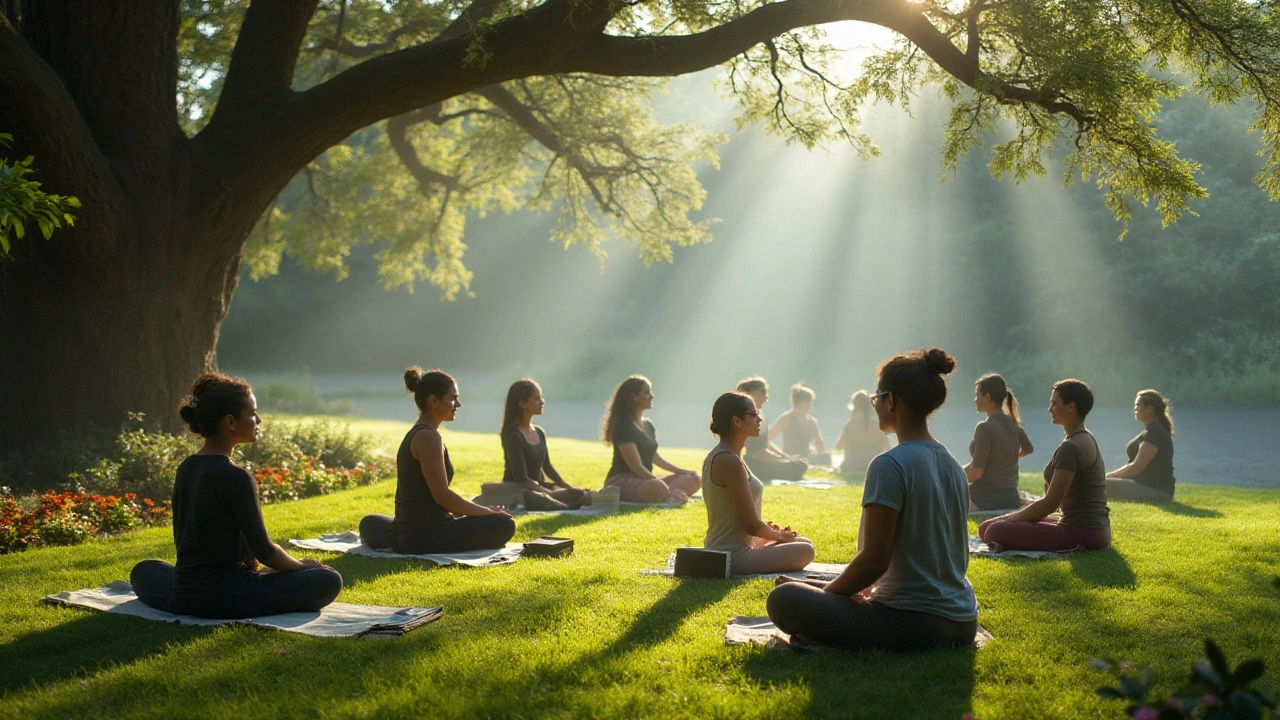In today's fast-paced world, finding time for self-care can be challenging, yet it is crucial for maintaining our health and well-being. Shiatsu, a Japanese therapeutic technique, offers a unique and effective way to nurture both body and mind, making it a valuable addition to your self-care routine.
Originating from the traditional wisdom of Japan, Shiatsu utilizes the power of touch through pressure applied on specific points of the body. This holistic approach aims to balance the body's energy flow, known as 'qi,' which helps in alleviating stress and promoting physical health.
With roots deep in ancient practices, shiatsu is not just massage therapy but a comprehensive way to enhance your lifestyle. Incorporating Shiatsu into your daily routine could be as simple as learning basic techniques to manage stress or finding a qualified practitioner for regular sessions.
- What is Shiatsu?
- History and Origins
- Techniques and Principles
- Benefits for Mind and Body
- Tips for Incorporating Shiatsu into Your Routine
What is Shiatsu?
Shiatsu, a revered therapeutic practice rooted in Japan, beautifully combines ancient wisdom with modern health benefits. Often referred to as 'finger pressure,' Shiatsu involves using thumb and palm pressure, along with various stretching techniques to stimulate the body's pressure points, which are also known as acupoints. This Japanese practice is akin to acupuncture, but without needles, focusing instead on healing through touch. As a form of bodywork that emerged in the early 20th century, it integrates the holistic principles of Chinese medicine and aims to balance the natural energy flow or 'qi' within the body.
This technique is based on the belief that health and wellness depend on the free flow of life energy through the body's meridian channels. When this energy is blocked or imbalanced, it can lead to discomfort and various ailments. Through specific pressure application, Shiatsu therapy seeks to clear these blockages, promoting harmony within both the physical and emotional realms of a person's being. An interesting aspect of Shiatsu is its adaptability; it's tailored to the needs of each individual, responding to their unique condition rather than just symptoms.
According to Tokujiro Namikoshi, a pioneer of Shiatsu, "the heart of Shiatsu is like pure love, gently warming humanity." This emphasizes its holistic approach not just towards physical healing but emotional well-being as well.
For those seeking natural methods for stress relief and relaxation, Shiatsu can be highly beneficial. The gentle movements and rhythmic pressure used in a session can help reduce anxiety and improve mood, while simultaneously fostering physical benefits like enhanced circulation, pain relief, and flexibility. Many individuals report experiencing a profound sense of calm and serenity after their sessions, with long-lasting effects on their overall energy levels and physical vitality. Therefore, integrating Shiatsu into one's routine is not just about addressing physical pain but also about nurturing the holistic connection between mind and body.
Adding Shiatsu to your wellness regime can be as straightforward or as intricate as desired. Many people start by incorporating simple techniques at home, focusing on tension hotspots like the neck or lower back. For a deeper experience, professionally guided sessions are recommended, where expert hands can intuitively work through complex patterns of tension and imbalance. Given its emphasis on personalized care, Shiatsu stands out as a staple for those cultivating a mindful approach to health.
History and Origins
Shiatsu, which translates to "finger pressure" in Japanese, has roots deeply entrenched in the rich tapestry of ancient Asian healing traditions. Emerging during the early 20th century, Shiatsu evolved from the harmonious blend of several age-old practices, including Anma (a traditional Japanese massage) and the foundational principles of Traditional Chinese Medicine (TCM). Anma, with its emphasis on rhythmic massages and focus on enhancing circulation, laid the groundwork for shiatsu's development. While Anma focused primarily on muscular and circulatory systems, TCM introduced concepts of energy flow, or "qi," which is intrinsic to Shiatsu's philosophy. This unique melding of tactile therapy and energy balancing principles set the stage for Shiatsu's growth into the profound practice it is today.
As Shiatsu evolved, Tokujiro Namikoshi played a pivotal role in shaping its identity by founding the Japan Shiatsu College in 1940. His work emphasized the physiological implications of pressure points and aimed at offering relief from common ailments through targeted acupressure. Importantly, Namikoshi's approach began to gain recognition beyond Japan, resonating with Western audiences for its blend of Eastern philosophy and pragmatic, physical application. As it journeyed across continents, Shiatsu's reliance on the body's innate healing power became integral to the world's understanding and acceptance of this therapy. According to the Shiatsu Society, "the holistic nature of Shiatsu aligns it closely with the growing global trend towards natural health solutions."
Continuing its voyage through history, Shiatsu maintained its roots in traditional Japanese and Chinese practices while evolving in response to modern health needs. In the 1980s, practitioners like Shizuto Masunaga introduced a variant known as Zen Shiatsu, which emphasised stretching and joint mobilisation. This adaptation broadened the spectrum of Shiatsu, making it more accessible and appealing to those seeking a comprehensive self-care solution. Zen Shiatsu's approach highlighted the energetic and emotional aspects of health, linking bodywork with the introspective aspect of personal wellness, thus ensuring that Shiatsu remains a versatile and dynamic method of therapy today.
Shiatsu's diffusion into various cultures has allowed it to adapt and absorb local influences while still maintaining its identity as a powerful therapeutic practice. In countries where Western medicine dominates, Shiatsu found a niche as a complementary therapy, aiding relaxation and overall well-being. As its reputation grew, so did the interest in studying its effects more rigorously, leading to notable research on its benefits. Studies show that regular Shiatsu sessions can significantly alleviate symptoms of stress, anxiety, and physical discomfort, attesting to its efficacy in enhancing quality of life for many. Whether through Namikoshi's classical methods or Masunaga's Zen Shiatsu, this gentle, yet profound art continues to offer profound healing to individuals seeking balance and restoration.

Techniques and Principles
Stepping into the world of Shiatsu reveals a mesmerizing blend of ancient wisdom and holistic healing that hails from Japan. At its core, Shiatsu translates to 'finger pressure,' and it intriguingly employs the rhythm of human touch to harmonize the body's energy. The primary aim of this practice is to ensure that the life energy, or Qi, flows smoothly throughout the entire body. This is crucial as any energy blockage could lead to discomfort or illness. Practitioners of Shiatsu use their fingers, thumbs, and even elbows to skillfully apply pressure on specific points known as meridians. These meridians are like energy highways that connect different parts of the body. While the techniques might appear simple, they are deeply rooted in traditional Chinese medicine and require a profound understanding of how the body's energy system operates.
Each session is uniquely crafted, as the practitioner needs to assess the individual's energy balance and physical condition. The pulses on the wrist and distinct areas of the body are softly examined to determine where the energy is stagnating. A notable fact is that each area of the body correlates with different organs; thus, complete knowledge of these body maps is essential. Over time, a practitioner develops an intuitive sense of how to manipulate these energies effectively. The therapeutic touch not only eases physical ailments but also offers a calm, meditative experience that benefits mental well-being.
There are various techniques within Shiatsu, each transcending beyond mere physical contact. 'Namikoshi Technique,' for example, emphasizes the anatomy and a scientific approach to the body. On the other hand, Zen Shiatsu centers around the fluid flow of Ki and often incorporates meditation into the practice. Both of these techniques ultimately cater to rejuvenating the body’s natural ability to heal itself. As you delve deeper into Shiatsu, the holistic connection of mind-body-spirit becomes evident, highlighting why it's a valuable approach in modern self-care routines.
"Shiatsu has a different meaning to each person, but it universally promotes an unparalleled balance," noted Shizuto Masunaga, a pioneering Shiatsu therapist in Japan. Such wisdom underscores that while the physical component of Shiatsu is significant, its invisible impact on emotions and stress levels is just as profound. By calmly working on the meridian points, Shiatsu can alleviate feelings of anxiety and help the body maintain a harmonious state.
For anyone exploring Shiatsu, it's valuable to understand these methods and principles deeply. While enrolling in classes or seeking a seasoned practitioner are excellent ways to get started, learning some basic techniques could be beneficial for personal practice at home. Given its capacity to improve both physical and mental health, Shiatsu is a promising tool for restoring balance, enhancing relaxation, and boosting overall vitality.
Benefits for Mind and Body
Delving into the practice of shiatsu reveals a tapestry of benefits intricately woven for both the mind and the body. At the heart of this Japanese therapy is its capacity to bridge the gap between physical tension and mental tranquility. Through an artful application of pressure on various points of the body, shiatsu achieves a harmony of energies that many modern self-care enthusiasts find indispensable. The technique primarily works to unblock and stimulate the pathways of qi, which can instantly uplift one’s mood and provide a burst of mental clarity.
On a psychological level, engaging in regular shiatsu sessions has been linked to a marked reduction in anxiety and depression. Practitioners often describe a profound sense of groundedness and balance that comes from these sessions. This is because the rhythmic and meditative nature of shiatsu encourages a relaxation response in the brain, thereby diminishing stress hormones and bringing about a state of calm. In a world where stress can easily accumulate, such relaxation techniques are not just beneficial; they are essential for maintaining emotional well-being.
"Shiatsu is not only a massage but also a communication tool, allowing the therapist to understand and balance the client's mind-body connection," says Shizuko Yamamoto, a renowned shiatsu practitioner.
Physically, the advantages of incorporating shiatsu into one's routine are equally impressive. The therapy is known for its ability to alleviate muscle tension, improve circulation, and even boost the immune system. Many people report that consistent shiatsu sessions help manage chronic conditions like arthritis or fibromyalgia, offering a gentle yet effective alternative to conventional pain relief methods. Additionally, shiatsu promotes the release of endorphins—the body’s natural painkillers—which enhances healing and rejuvenation on multiple levels.
For those engaged in rigorous daily routines, the revitalizing effects of shiatsu cannot be overstated. As the therapy improves blood flow, it also contributes to increased energy levels by ensuring that oxygen and nutrients are efficiently delivered throughout the body. This holistic approach means that shiatsu doesn’t just target isolated symptoms; it fosters an environment where overall health and vitality can thrive, making it a cornerstone in a comprehensive self-care regimen.

Tips for Incorporating Shiatsu into Your Routine
Bringing Shiatsu into your daily life can be a transformative experience, melding stress relief with wellness benefits that transcend the ordinary. First, it's important to find quiet moments in your day dedicated to this practice. Even a few minutes can be enough to center yourself and enhance mindfulness. Start by understanding your body's energy. This involves locating specific pressure points which, according to traditional beliefs, align with the flow of qi. Learning to identify these points can be beneficial, not only during a session but throughout your day. By applying gentle pressure to these key areas, you can reap the benefits of shiatsu's therapeutic touch.
One practical step is to create a soothing environment for practice. Whether at home or work, a serene space free from clutter promotes relaxation and focus. Pay attention to lighting—soft, warm lighting can make a significant difference in setting the mood. Likewise, calming music or nature sounds can enhance the tranquility of your session. With these elements in place, your self-guided shiatsu can become a habitual relaxation ritual. It's worth noting that shiatsu is adaptable; it doesn't demand a strict schedule. Flexibility is key—inject a brief session into breaks or moments of stress when you can.
For those new to self-care through shiatsu, starting simple is best. Identify a few key pressure points to focus on, easing gradually into more complex routines as you understand your body's responses. Engaging with communities, either online or locally, can provide fresh insights and encouragement from others who practice. Alternatively, seek guidance from a professional shiatsu therapist to learn advanced techniques. Over time, you might develop a deeper sensitivity towards your body's needs, responding naturally with the skills you've gathered. According to Dr. Masunaga, a renowned practitioner, "Shiatsu teaches us the language of the body."
Supporting your practice with proper information is crucial, so consider investing in a few good books or resources on Japanese therapeutic massage. These can offer detailed insights into anatomy, technique, and philosophy, enriching your understanding. With practice, shiatsu can become more than a task; it becomes a celebration of self-awareness and care. For those keen on the scientific side, studies have shown that regular shiatsu practice can reduce symptoms of anxiety and fatigue, fostering a healthier lifestyle. Creating a log or journal of your experiences can also be insightful, helping you track improvements and understand what works best for you.
The beauty of integrating shiatsu into your life is its potential to evolve with you. As your life and circumstances change, so too can your practice. Whether you are engaging in solo sessions or enlisting the help of a therapist, remember that your comfort and relaxation are of utmost importance. Embrace this journey with patience and commitment, acknowledging each improvement, no matter how small. With time, Shiatsu will not just complement your self-care routine but become an integral part of how you sustain wellness throughout life's challenges.


 Health and Wellness
Health and Wellness